Inhibiting the African Great Lake of Malawi, the red zebra cichlid (Maylandia estherae) is known for its diverse color and behaviors.
If not provided with ample space to hide and swim around during breeding seasons, male red zebra cichlids can become pretty territorial and show aggressive behavior towards tank mates.
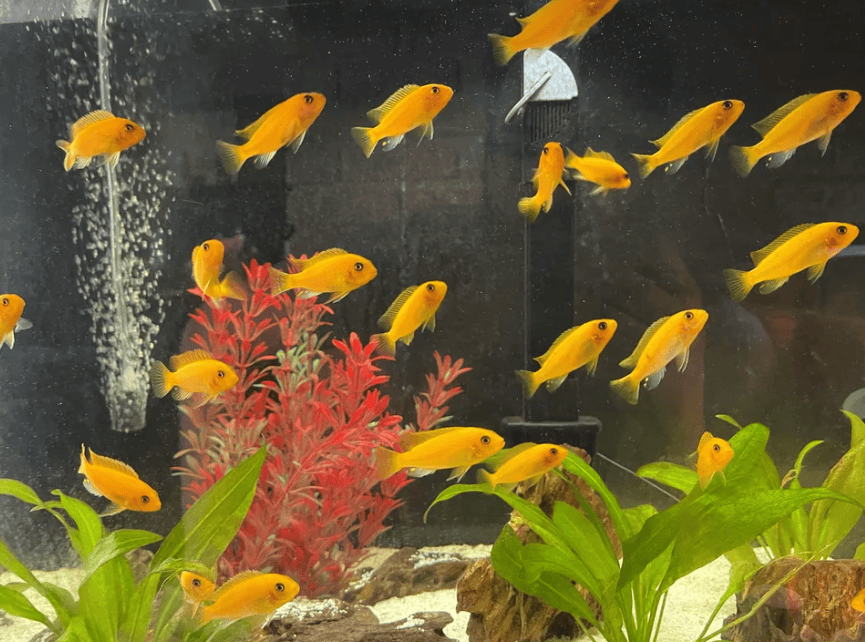
A particularly interesting trait of red zebra cichlids is their maternal mouthbrooding. The female reds carry and protect their eggs and fry in their mouths until they’re ready to swim freely. During this time, the female may not even eat to leave no room for the eggs to escape.
In this article, we’ll dive deeper into giving proper care to the red zebra cichlids and understand their behaviors in detail.
Table of Contents
Red Zebra Cichlid Overview
Living in the rocky shorelines of Lake Malawi, Red Zebras are small fish part of the larger cichlid family. They compensate for their lack of size with their natural aggression and omnivorous diet. Here is a brief overview of the elements that we’ll discuss throughout the article in great detail.
| Information Chart | Red Zebra Cichlid |
| Scientific Name: | Maylandia estherae |
| Family: | Cichlidae |
| Care Level: | Moderate |
| Temperament: | Territorial and aggressive |
| Color: | Male: Vibrant red Female: Pale silver or yellow |
| Lifespan: | 5 to 8 years |
| Size: | 4 – 5 inches |
| Diet: | Omnivorous diet, ranging from small invertebrates to algae. |
| Minimum Tank Size: | 40 gallons for 4-5 red zebra cichlids |
| Temperature: | 75-82°F |
| WaterConditions: | pH: 7.8 to 8.6GH: 8 – 12 dGH |
| Tank Mate Compatibility | Compatible with: Lake Malawi cichlids, Mbuna cichlids, bottom-dwelling catfish, non-aggressive species. |
Appearance
Red Zebra Cichlids have a relatively streamlined shape, with their body being flat from side to side—allowing them to navigate easily through the water. Being inhabitants of the rocky shores, this helps them hide from predators more effectively.
Males of the species are a bit larger than the females, with both of them growing up to 4-5 inches. More refined and robust body proportions also are prevalent in male reds.
Intensifying during breeding seasons and showing dominance, male red zebra cichlids display bright red or orange bodies with vertical black stripes. Females, however, lack in this domain and show a rather underwhelming silvery appearance.
Fins also contribute to the overall gracious appearance of red zebras. More prominent in males, the dorsal and anal fins are typically elongated and have darker edges. Other fins, such as pectoral or pelvic fins, aren’t as enticing.
While most red zebra cichlids showcase black vertical stripes, there may be other stripe patterns, such as more pronounced or wider bars, and subtle body color variations.
Types of Red Zebra Cichlid
There are no taxonomically recognized variations of red zebra cichlids. However, as a result of generations of selective breeding, cichlid enthusiasts can distinguish between a few traits based on coloration.
- Ruby Red Zebra: This variation of red zebras exhibits a rich, deep, coloration, with intense black vertical bars.
- Orange Blotch Zebra: OB zebras showcase irregular blotches of oranges throughout their body. The patterns often vary.
- Albino Red Zebra: Creamy white in appearance, albino red zebras have pink or red eyes—adding to their overall vibrance. They lack black pigmentation.
- Snow White Zebra: Also lacking black pigments, this variation demonstrates a predominantly white body coloration with no black bars.
Lifespan of Red Zebra Cichlid
In captivity, red zebra cichlids are observed to be alive and “kicking” even up to 10 years. While it may typically halve in the wild, genetic factors, water quality, and diet may also influence their lifespan in your aquarium.
Here are a few factors that may shorten the lifespan of your reds:
- Genetics
Some individual red zebra cichlids may inherit genetic predispositions, making them susceptible to certain diseases.
- Water quality
If you fail to maintain optimum water quality for the cichlids or let toxic substances like ammonia, nitrate, and nitrate rise beyond tolerable levels, it’ll shorten your reds’ lifespan.
- Diet and nutrition
Don’t overfeed your red zebras or offer them a diet that’s not balanced. Not providing a nutritious diet may shorten their lifespan to a huge degree.
- Tank size and environment
Overcrowding, insufficient hiding spots, or inappropriate tank mates can put undue stress on the red zebra cichlids and may impact their lifespan.
- Diseases
Red zebra cichlids are susceptible to a few diseases like Swim Bladder Disease and Malawi Bloat. Failing to provide them with proper care and medication may reduce their lifespan.
- Breeding
Female reds go through a lot of physical stress during breeding. The demanding process of carrying the eggs, caring for them, and starving hugely impacts their lifespan.
Red Zebra Cichlid Size
Captive-bred red zebra cichlids often grow to a 4 to 5 inches size, with males being slightly larger than females. However, a lot of factors that influence the lifespan of it may also hinder its growth.
The primary consideration to grow bigger zebras is to keep them in a larger tank with proper substrate and decorations. Make sure to get them at least 48-50 inches of horizontal swimming space for maximum growth.
Regular water changes, at least 50%, also have been shown to facilitate faster growth. In addition, a more balanced diet with portion control and higher frequency may help them grow up to the upper spectrum.
Red Zebra Cichlid Care & Tank Set-Up
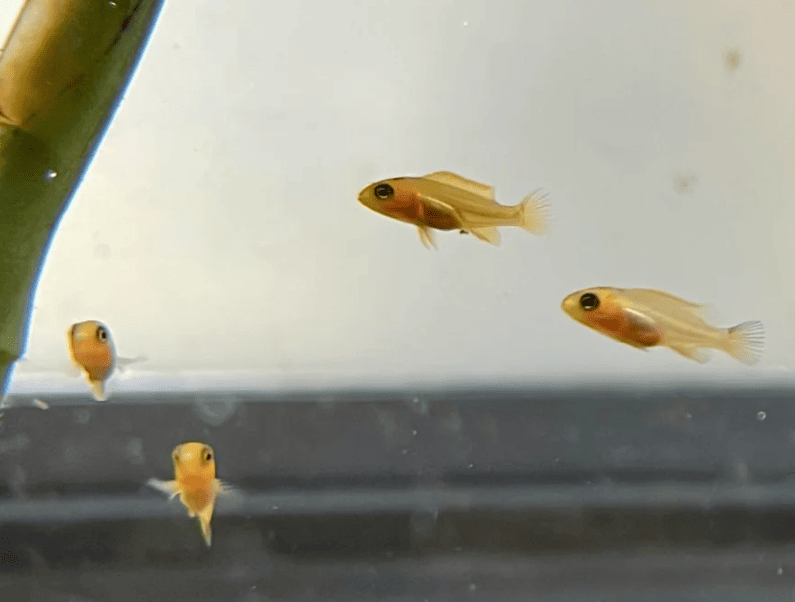
Moving on from basics, let’s dive deeper into red zebra cichlid care and tank setup. In this section, we’ll discuss tank elements like tank size, water parameters, and landscapes necessary to sustain healthy red zebra cichlids.
Tank Size and Specifications
Thanks to their hearty appetite and voracious eating habits, cichlids have a relatively high bioload, meaning that they generate more waste than other fish species. Not having enough tank space or a filtration system to serve high-bioload fish species can become a cause of diseases and death.
Optimum Tank Size
A small group of Red zebra cichlids can be kept in a 40-gallon tank without any issues. While more is always better, going higher than that is wasteful and unnecessary. Being active swimmers, they’re happy with having a lengthy tank than a wider one.
Appropriate dimensions for a 40-gallon red zebra cichlid tak would be (L X W X H): 36 inches x 18 inches x 16 inches. However, you may experiment with the dimensions to fit your requirement better.
Remember, 231 cubic inches make 1 gallon, and 1 gallon makes 3.7854 liters.
Filter Type
You need to employ strong mechanical and biological filtration to keep red zebra cichlids. To support their high bioload, canister filters, and strong HOB filters are the best choices for filtration systems. However, consider keeping the flow rate in a comfortable region.
Mechanical filtration removes dirt, physical debris, and particulate matter from the water. Hang-on-the-back (HOB) filters with filter floss, foam, and filter pad are suitable for the operation.
Biological filtration ensures the removal of toxins, such as ammonia, nitrate, and nitrite, from the aquarium environment. These systems help beneficial bacteria to colonize the filter media to break down the toxins into harmless components. Canister filters are particularly effective for this purpose.
Substrate
Native to Lake Malawi, red zebra cichlids prefer fine-grained sand as their choice of substrate. Soft sand allows them to exhibit their natural burrowing and sifting behavior. As a keeper, you would also love how easy to maintain sand is, as substrate.
Another popular substrate choice for red zebras is crushed coral. As they prefer slightly alkaline water, coral dust helps you maintain pH to the desired level. Moreover, crushed coral mimics their natural habitat.
On a different note, aragonite substrates are also preferred by red zebra enthusiasts to maintain pH levels.
How many Red Zebra Cichlids in X Gallon Tank
4-5 red zebra cichlids can be kept in a 40-gallon tank.
Water Parameters for Red Zebra Cichlid
Optimum water parameters are critical for your cichlid to thrive. A collapse of fundamental parameters in the aquarium can put your reds in chemical shock. This, if continued, may fluster their color or prove fatal.
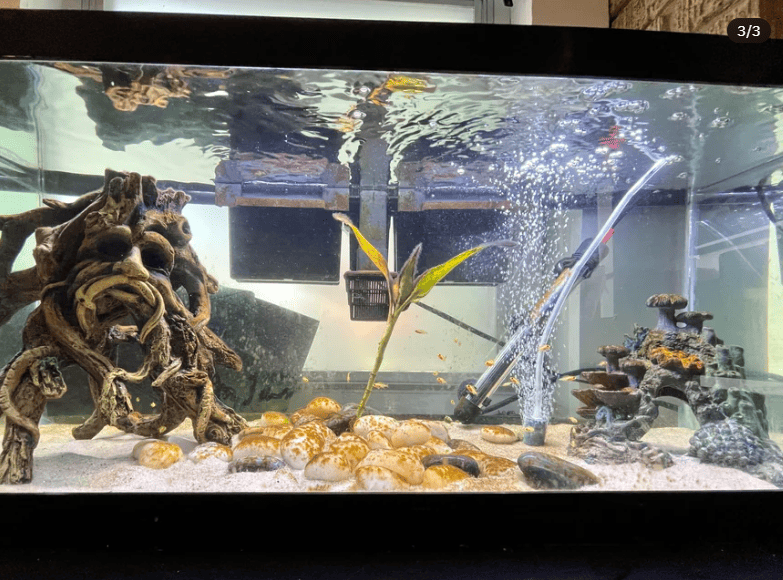
Toxic substances in the aquarium, namely ammonia, nitrite, and nitrate, are best to be kept near a zero level. The other parameters are discussed below.
Water Temperature
Red zebra cichlids prefer a slightly warmer temperature, between 75 to 82 F (24 to 28 C). Although they are capable of surviving much higher temperatures, you shouldn’t put them to the test.
Depending on your location, you may need to reduce or increase the water temperature to maintain the levels. Here is how:
- Aquarium heaters are the most common and effective way to increase water temperature. Good quality heaters usually come with an auto cut-off feature to maintain a stable temperature.
- Another method is to increase the room temperature. By adjusting the room temperature, the water temperature will also gradually be impacted.
- If you prefer a safer option that won’t electrocute your fish, you can consider using heating pads designed specifically for aquariums.
- To decrease the water temperature, you may use aquarium chillers. These devices are designed to reduce the temperature of the water to a desired level set by the thermostat.
- Another method is to place a fan near the surface of the aquarium. This helps to reduce the water temperature by promoting evaporation. However, it’s important to ensure that the fan is not directly facing the surface of the water to avoid excessive evaporation.
- Additionally, you can use ice packs or frozen water bottles to cool the water. Performing water changes with colder water can also help lower the temperature, although it is not as sustainable as the other methods mentioned.
Water Flow Rate
A moderate flow rate of 200 to 400 GPH is considered adequate for a 40-gallon red zebra tank. The rule of thumb for a moderate flow rate is 5 to 10 times the tank size. This ensures a gentle water flow and avoids creating a strong current that may cause stress to the fish.
While powerheads and wavemakers may be used to create the flow, filter heads are often enough for the purpose. However, make sure that a consistent water flow is achieved throughout the tank, covering every corner and crevice. If not, employ additional equipment.
When setting up the aquarium for the first time, observe the behavior of your cichlids to ensure that they aren’t constantly struggling against the current. Reduce the flow further, if that happens.
pH Level
A slightly alkaline pH of 7.8 to 8.6 is optimum for red zebra cichlids. You must emphasize maintaining the pH levels for the overall well-being of the red zebras. Their enzyme activities, ion balances, osmoregulation, and respiratory functions are heavily optimized for the particular range of pH.
A spike or imbalance in pH levels may cause:
- Stress and discomfort: Behavioral changes and reduced appetite are the resultants of stress and discomfort caused by significant pH deviations.
- pH shock: Rapid pH changes can hinder physiological processes in red zebra cichlids.
- Impaired immune system: Extreme deviations in pH levels can cripple the immune system of red zebra cichlids, making them susceptible to diseases and infections.
- Reproductive issues: Poor egg viability and survival have a direct correlation with pH imbalance.
To increase ph levels, crushed corals or limestone are one of the most commonly used elements. As these materials contain calcium carbonate, it gradually increases the pH levels of your tank. Further, you may use baking soda, and commercial pH increases to maintain adequate pH levels.
To decrease pH levels, adding driftwood or peat moss can help. Commercial pH decreasers, CO2 injection, and RO water blending also are viable options. CO2 injection is generally used in planted tanks, but you may use it for cichlids.
Water Hardness
Red zebra cichlids thrive on a water hardness of 8-12 dGH. Maintaining an adequate general hardness is essential for:
- Natural habitat replication: Inhabitants of Lake Malawi, red zebra cichlids are acclimated to hard water.
- Mineral intake: Minerals, such as calcium and magnesium, are important for the overall health and development of cichlids.
- pH stability: Hard water has a higher buffering capacity and stabilizes pH levels more effectively.
- Osmoregulation: Red zebra cichlids maintain water and mineral balance in the body through osmoregulation. Water hardness influences the flow of water and ions across the fish’s gill and body surfaces.
A few pro tips involving water hardness:
- Mix distilled or RO water with your existing tank water to lower water hardness.
- Acid buffers may be used to lower water hardness, but that also lower pH values.
- Local water sources often change their reservoirs seasonally. Always test the tap water before major water changes.
Red Zebra Cichlid Tank Landscape
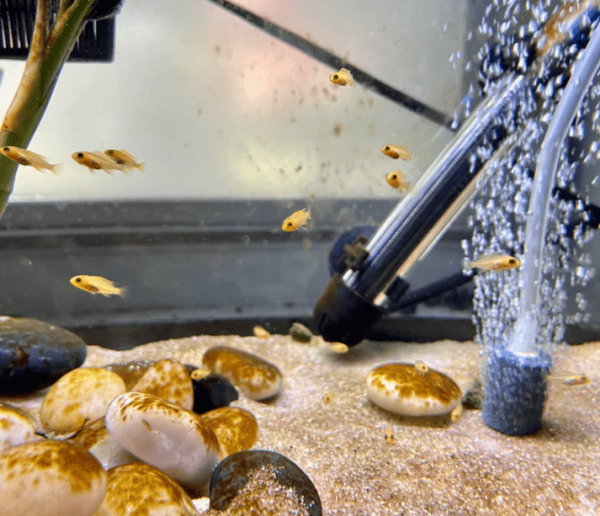
Tank landscape is pretty important for cichlids when it comes to replicating the natural environment. Plants and decorations play a major role in sustaining the health and well-being of your red zebra cichlids.
Best Plants for Red Zebra Cichlid Tanks
Owing to their natural behavior, red zebra cichlids may try to uproot aquatic plants during rage episodes. Retrospecting, here are a few plants that you may choose from:
- Anubias: Anubias are hardy plants that can withstand the abuse presented by red zebra cichlids. Anchor them to driftwood or rocks using fishing lines to prevent them from being uprooted.
- Java Fern: Let java ferns float from rocks or driftwood. However, avoid burying the rhizome in the substrate.
- Vallisneria: Vallisneria is a good choice for cichlid tanks due to its long, grass-like leaves that provide cover. Ensure well-anchoring.
Worst Plants for Red Zebra Cichlid Tanks
Plants with delicate and fine leaves aren’t suitable for red zebra cichlids. Their delicate foliage can easily be uprooted.
On the other hand, carpeting plants like dwarf baby tears or monte carlo, may not fare well with reds. Floating plants also aren’t suitable for your cichlid tank due to them being susceptible to nibbling and disturbance by the fish.
Stem plants, including ludwigia and hygrophilia, can be challenging to keep with red zebra cichlids.
Decorations for Red Zebra Cichlid Tanks
Being pretty territorial, decorations as hiding and exploration spots are critical for red zebra cichlids. A few of the suitable ones may include:
- Rocks and caves: Use large, smooth rocks stacked together to form caves to offer hiding space for your cichlids.
- PVC Pipes: Cut lengths of PVC pipes and arrange them in the tank to provide additional hiding spots and boundaries. They can be effective and cheap decoration options.
- Driftwood: Choose smooth Aquarium driftwood to decorate your aquarium and offer additional territorial boundaries for your reds.
Lighting for Red Zebra Cichlid Tanks
There are no additional lighting requirements for red zebra cichlids. Providing ample lighting for the plants should be adequate for your cichlid tanks.
Feeding Red Zebra Cichlids
Omnivorous red zebra cichlids are known to devour anything and everything in their path, including plant leaves. As a result, overfeeding is a pretty consistent issue in cichlid tanks.
Best Diet for Red Zebra Cichlids
Some dietary recommendations for red zebra cichlids are:
- Cichlid pellets: Look for cichlid pellets made exclusively for African cichlids with the right combination of proteins, carbs, and vitamins.
- Frozen or live food: Frozen or live brine shrimp, daphnia, bloodworms, and other insects are suitable to feed red zebras.
- Vegetable matter: You may also offer them peas, zucchini, and spinach to provide fiber and other essential nutrients.
Whatever your preferred diet choice is, make sure to feed them in small portions frequently.
How often should you feed Red Zebra Cichlid?
Feed your red zebra cichlids 3-4 times each day in small portions.
Red Zebra Cichlid Tank Mates
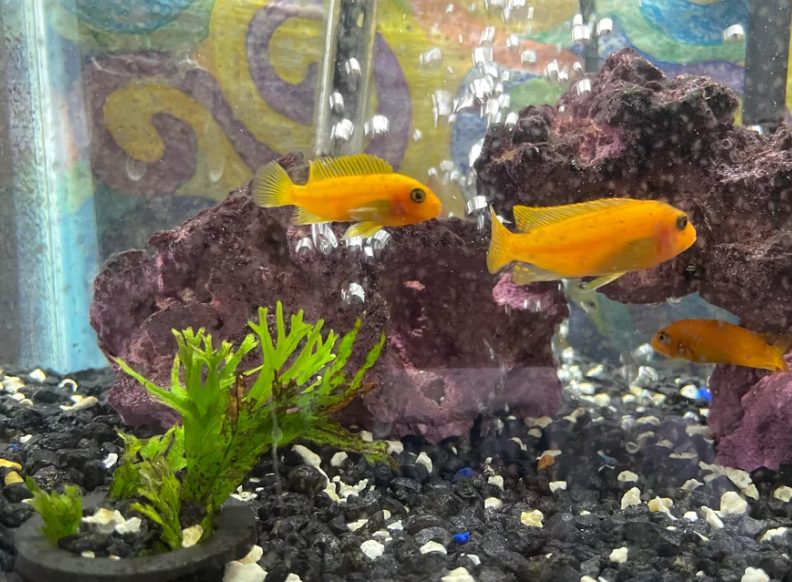
Owing to their territorial behavior and social hierarchy, red zebra cichlids don’t make very good tank mates. We’ll discuss a few good and bad tankmates for red zebras that are worth mentioning.
Ideal Red Zebra Cichlid Tank Mates
Most ideal red zebra cichlid tank mates are:
- Other African cichlids from Lake Malawi, such as Acei Cichlids, Demasoni cichlids, etc.
- Peaceful Lake Malawi haplochromines, like Red Top Hongi and Blue Dolphin Cichlid, etc.
- Syndontis catfish
Bad Tank Mates for Red Zebra Cichlid
You must avoid passive fish that can easily be targeted to show aggression and feeding competitiveness. Tetras, guppies, and other timid species shouldn’t be kept near your tank.
Bottom-dwelling fish with long fins should also be avoided as tank mates for red zebra cichlids.
Breeding Red Zebra Cichlid
Although the incubation period may be a bit different, as an aquarium hobbyist, breeding red zebra cichlids can be a rewarding experience for you.
The first step toward successful red zebra cichlid breeding is to prepare a breeding tank with hiding spaces, rocks, caves, and shelter. Proper filtration and water quality parameters should also be maintained.
Choose a breeding pair. Observe your fish to find a dominant male and compatible female. Introduce them to the breeding tank.
Offer a high-quality diet, including pellets, flakes, and frozen food to condition them for the breeding process. During this time, the male will start displaying courtship behaviors, such as vivid coloration and fin flaring. The female will also start showing submissive behavior.
The male red will guide the female to a breeding site where the female will lay eggs, and the male will fertilize them before she can put them into her mouth for incubation. The female will not eat during the incubation period.
Once the fry is ready to swim away, remove the breeding pair and offer the fry ample space to hide. Provide them with crushed flakes and pellets. Move them to another appropriate tank with an adequate filtration system.
Common Diseases and Their Treatment
Malawi Bloat
Malawi bloat is characterized by a swollen abdomen if affected red zebra cichlids and symptoms like loss of appetite, lethargy, and rapid breathing may be observed.
Usual treatments include:
- Fasting the affected fish for a few days often relieves the stress.
- An improved diet helps with the bloat.
- Medication may be necessary. Consult your vet for the same.
- An improved water quality helps with the situation.
Swim Bladder Disorder
Failing to maintain a stable position in the water, swim bladder disorder hinders the fish’s ability to swim freely. Overfeeding, constipation, and injuries are the primary reason for the disease.
Usual treatments involve:
- Feeding adjustments and offering an appropriate diet.
- Fasting the fish till the situation improves.
- Improved water quality.
- Medication.
Check out our article on “How To Care For Guppies“.
Are Red Zebra Cichlids Right For You?
While red zebra cichlids don’t require premium attention, you need to give them adequate care. Moreover, as they are messy eaters and produce huge waste, employing a generous filtration system and regular water changes are essential. The reds are right for you if you can provide them with the proper take setup, care, decorations, and diet.
Conclusion
From their stunning appearance to their behavior and tank requirements, this article covers all the essential aspects to ensure the well-being of these beautiful fish in your aquarium.
No related posts.
